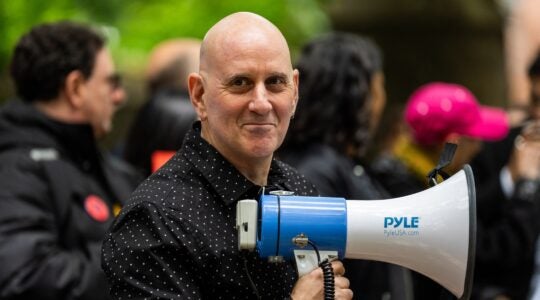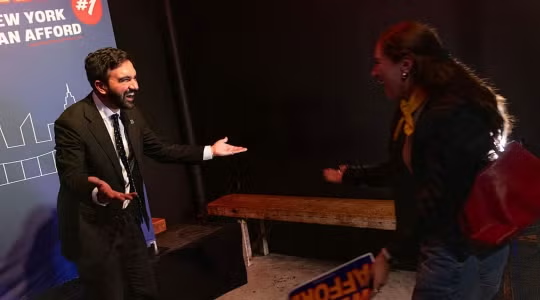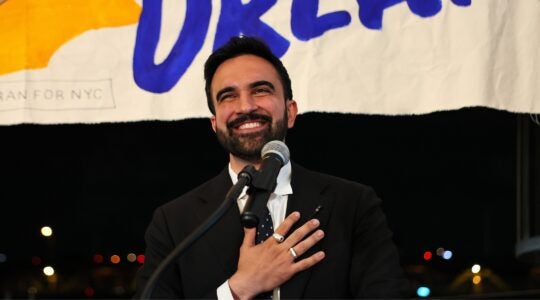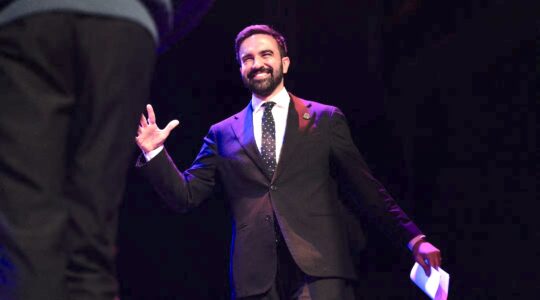Every few years a poll comes out showing how little the general public knows about the Holocaust: in 2005, a poll found that only 40 percent of Canadians could correctly identify the number of Jews killed in the Holocaust, while one in six thought the number was less than a million. A BBC poll that year revealed that half of Britons had never even heard of Auschwitz.
But Timothy Snyder, a young Yale historian attracting much attention, suggests that polls like these are themselves wrongheaded. The focus on Auschwitz and death camps in general distorts the picture of how most Jews were actually killed, he says. More than half were murdered by mobile firing squads dispatched throughout Eastern Europe, often aided bylocal villagers, not Nazis. And as far as death camps go, Auschwitz was not where most murdered Jews went to die. East European Jews represent the vast majority of the victims, and they were gassed in camps like Treblinka, Sobibor and Belzec.
“Auschwitz was important, but not as important as you might think,” Snyder said in a recent interview near Washington Square Park. “About half of the Jews died by way of bullets,” he said, adding, “When people write about the Holocaust it’s not very often put in its right setting.”
Snyder will publish a new book next fall placing the Holocaust in the broader context of mass killings under both Hitler’s and Stalin’s reigns. Titled “Bloodlands: Europe between Hitler and Stalin” and published by the trade house Basic Books, it will reach a much larger audience than the academy tends to allow. But Snyder has already found a significant following with his provocative essays for publications like the New York Review of Books and the Times Literary Supplement.
Snyder’s approach to the Holocaust may make some uneasy since it might appear to reduce its magnitude by placing it within a much larger context of mass death, and because it attacks the Holocaust’s central symbols, like Auschwitz. Some historians have already begun to question Snyder’s work.
“He’s absolutely right that part of the Holocaust is not adequately discussed,” said Robert Jan Van Pelt, a Holocaust historian and co-author of “Holocaust: A History” and “Auschwitz.” “But I think he’s too polemical in his argument. He makes his case too strongly.”
While several historians interviewed applaud Snyder for highlighting overlooked facts, they say the facts themselves are not new. Moreover, some say Snyder’s emphasis on exact numbers and specific geography misses the uniqueness of the event, of which Auschwitz is still the best symbol.
“You shouldn’t play the numbers game,” said Deborah Dwork, professor of Holocaust history at Clark University and a co-author with Van Pelt. “All credit to Snyder for highlighting the Germans’ general plan,” she said, adding that though the death camps do not represent the majority of Jewish deaths, they exemplify the Final Solution.
About one of the six million Jews killed by the Nazis died in Auschwitz, with another combined million-and-a-half in the death camps of Treblinka, Sobibor and Belzec. Despite the fact that more Jews were killed by gunshot and tossed into unmarked graves throughout Eastern Europe, Dwork and others still argue that Auschwitz embodies the anti-Semitic aims of Hitler. “Other events are very difficult to package in a story,” said Van Pelt. But Auschwitz “is the perfectly organized story” — Jews were put in trains, sent to camps, then gassed to death.
Snyder says his point is not to minimize the horrors of Auschwitz and the death camps, but to add to our understanding of them. The Jews were only the first to go in a much larger plan that would have murdered or relocated almost 30 million people — including non-Jewish Ukrainians, Poles and Slavs — who lived on land Hitler planned to colonize. The public must also reckon with the other five million civilians, most not Jewish, that Stalin murdered between 1928 and 1953 through intentional famines and not the better-known system of gulags. “If people are interested in what the Holocaust was, they should want to understand what Hitler’s real plans were,” he said.
Snyder gained significant attention when he elaborated on these ideas in an essay titled “The Ignored Reality,” published in the New York Review of Books in July. In it, he wrote, “If we concentrate on Auschwitz and the Gulag, we fail to notice that over the period of 12 years, between 1933 and 1944, some 12 million victims of Nazi and Soviet mass killing policies perished in a particular region of Europe, one defined more or less by today’s Belarus, Ukraine, Poland, Lithuania and Latvia.”
The essay ricocheted around the Internet and landed in several prominent historians’ inboxes. Van Pelt said that the organizers of a Holocaust conference this October asked him to present the essay after several participants began discussing the article beforehand. Michael Marrus, an emeritus professor of Holocaust history at the University of Toronto, said that colleagues in Europe have also been asking about Snyder. “I have colleagues in Germany who’ve called and said, ‘Oh, have you read Tim’s work? It’s so interesting.’”
Even the United States Holocaust Memorial Museum in Washington decided to focus on Eastern European deaths as part of its annual conference, happening next month. While Paul Shapiro, the director of the museum’s Center for Advanced Holocaust Studies, said Snyder was not the only one focusing on the issue, he has done a lot to raise the issue’s profile. “It’s quite a systemic effort to bring better balance to the way we teach the Holocaust,” he said.
But while most support Snyder’s argument, they contend that he has not said anything that other historians don’t already know. Snyder has been able to increase the understanding of the scope of mass death in Eastern Europe because of the opening of Soviet archives that began after the fall of the Berlin Wall, in 1989. But much of the information he cites has already been analyzed and written about by other authors.
For instance, Mark Mazower’s “Hitler’s Empire: Nazi Rule in Occupied Europe,” published last year, focused on the Holocaust as part of Hitler’s larger aim to colonize other European lands. Jan Gross was nominated for a National Book Award in 2001 for “Neighbors,” which focused on local Polish collaboration with the Nazis. And it was a Catholic priest, Father Patrick Dubois, who last year won the National Jewish Book Award for “The Holocaust by Bullets,” which focused on the one-and-a-half million Jews killed by mobile Eisengruppen units in Ukraine.
“Scholarship has been shifting eastward for the last two decades,” said Christopher Browning, a Holocaust historian at the University of North Carolina at Chapel Hill. Browning said he read parts of Snyder’s upcoming book in manuscript form, and that the “Ignored Reality” essay also caught his attention. “What I liked about it most was that it synthesized what’s been going on in the last two decades.”
Snyder, who has been on sabbatical after eight years teaching at Yale, was visiting New York over the weekend and answered some of the criticisms during an interview. He admitted that there was not much new information in his latest work, but his goal was to synthesize all the information that has already been published.
The fields of Holocaust history and Eastern European history have not been on speaking terms for decades, he said. And the result has been that Holocaust historians fail to see Hitler’s larger aims, while Eastern European historians fail to comprehend the Holocaust. “What I realized is that the two sides have to be brought together,” he said.
But did he risk minimizing the magnitude of the Holocaust by doing so? No, he said. “I agree that the Holocaust is special … When you write a comparative book you can only come up with the conclusion that Hitler killed more people then Stalin, and the Jews were the worst victims.” But he was not interested in cultural politics, and felt that words like “unique” and “special” were hardly appropriate anyway. “If you’re going to say [the Holocaust is] ‘unique’ because of the gas chambers, then what are you saying about the other half [who died by firing squads]?”
Snyder has suggested in other writings that certain facts of American popular culture have prevented a complete understanding of the Holocaust. In a book review on the Web site Truthdig.com, he argued that popular books in translation, like Anne Frank’s diary and the works of Primo Levi, give the false impression that most Jews who died in the Holocaust were from Western Europe, or went to death camps, like both those authors. But one important reason we don’t know more about the firing squads and other death camps is because so few victims survived.
American taboos about Communism, he also suggests, have prevented a full understanding of partisan groups, many of them with Jews, who allied with the Red Army. Even recent movies that have highlighted the better-known ones like the Bielski brigade, portrayed in the film “Defiance,” have downplayed their importance to the Soviet victory. “Some students of modern Jewish history, particularly in the United States, treat the issue of Jewish communists as taboo,” Snyder wrote. “This would have made no sense to the survivors … many of whom saw themselves precisely as both communists and Jews.”
Snyder goes on to say that simple tales about heroism and victimhood obscure an adequate historical picture. “Jewish communist partisans in Belarus or Ukraine obviously seem heroic as enemies of the Nazis and avengers of their families,” he writes. But “their legacy is muddled by the fact that they bore arms to defend a system that had killed 3.5 Ukrainians and a similar number of Kazakhs by famine 10 years before, and a million other Soviet citizens by execution in 1937-1938.”
None of this, Snyder said in the interview, was a deliberate attempt to upset certain pieties. “This doesn’t mean that the Holocaust is any better or any worse. It makes it more resonant, more true. It should help us see the whole picture and just how awful the Holocaust was.”
The New York Jewish Week brings you the stories behind the headlines, keeping you connected to Jewish life in New York. Help sustain the reporting you trust by donating today.




